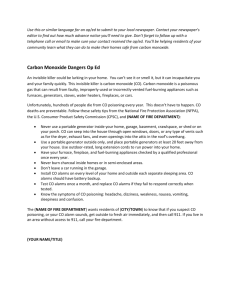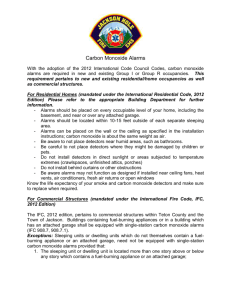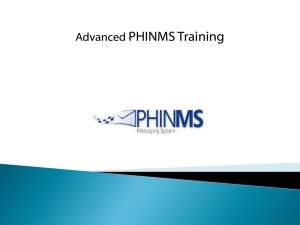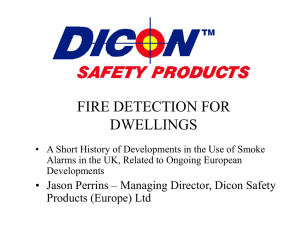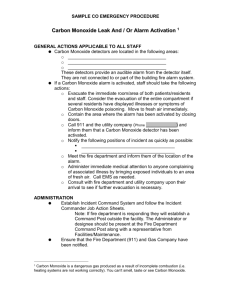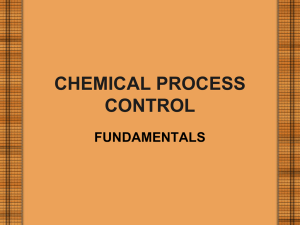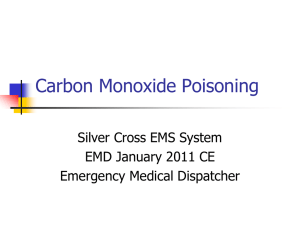File
advertisement
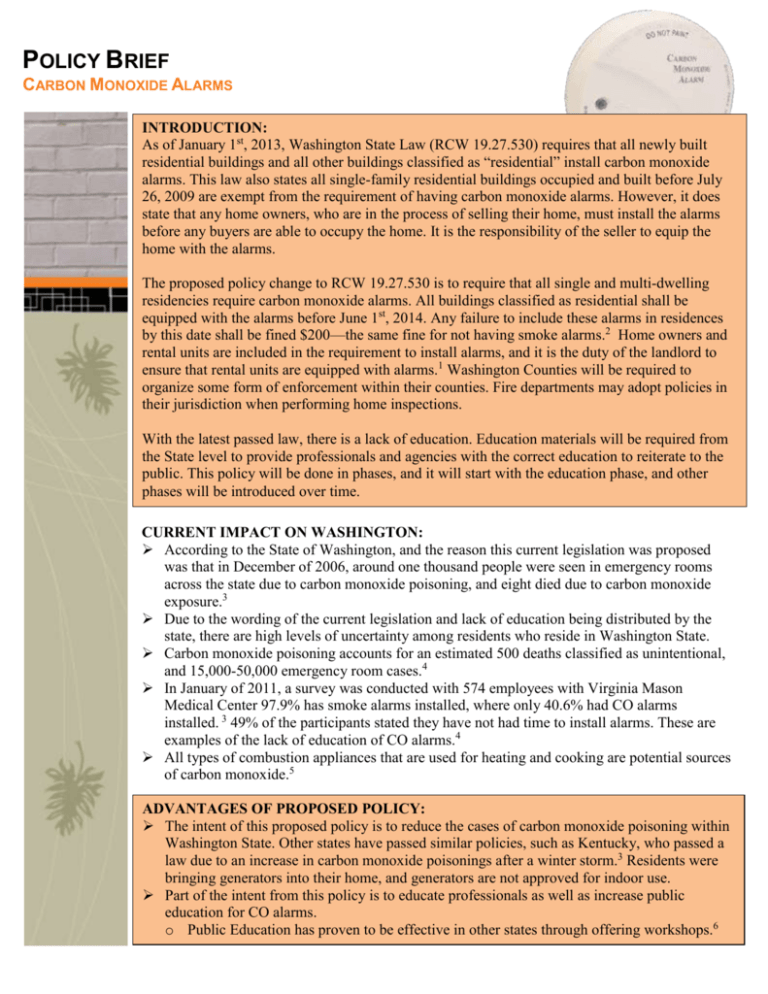
POLICY BRIEF CARBON MONOXIDE ALARMS INTRODUCTION: As of January 1st, 2013, Washington State Law (RCW 19.27.530) requires that all newly built residential buildings and all other buildings classified as “residential” install carbon monoxide alarms. This law also states all single-family residential buildings occupied and built before July 26, 2009 are exempt from the requirement of having carbon monoxide alarms. However, it does state that any home owners, who are in the process of selling their home, must install the alarms before any buyers are able to occupy the home. It is the responsibility of the seller to equip the home with the alarms. The proposed policy change to RCW 19.27.530 is to require that all single and multi-dwelling residencies require carbon monoxide alarms. All buildings classified as residential shall be equipped with the alarms before June 1st, 2014. Any failure to include these alarms in residences by this date shall be fined $200—the same fine for not having smoke alarms.2 Home owners and rental units are included in the requirement to install alarms, and it is the duty of the landlord to ensure that rental units are equipped with alarms.1 Washington Counties will be required to organize some form of enforcement within their counties. Fire departments may adopt policies in their jurisdiction when performing home inspections. With the latest passed law, there is a lack of education. Education materials will be required from the State level to provide professionals and agencies with the correct education to reiterate to the public. This policy will be done in phases, and it will start with the education phase, and other phases will be introduced over time. CURRENT IMPACT ON WASHINGTON: According to the State of Washington, and the reason this current legislation was proposed was that in December of 2006, around one thousand people were seen in emergency rooms across the state due to carbon monoxide poisoning, and eight died due to carbon monoxide exposure.3 Due to the wording of the current legislation and lack of education being distributed by the state, there are high levels of uncertainty among residents who reside in Washington State. Carbon monoxide poisoning accounts for an estimated 500 deaths classified as unintentional, and 15,000-50,000 emergency room cases.4 In January of 2011, a survey was conducted with 574 employees with Virginia Mason Medical Center 97.9% has smoke alarms installed, where only 40.6% had CO alarms installed. 3 49% of the participants stated they have not had time to install alarms. These are examples of the lack of education of CO alarms.4 All types of combustion appliances that are used for heating and cooking are potential sources of carbon monoxide.5 ADVANTAGES OF PROPOSED POLICY: The intent of this proposed policy is to reduce the cases of carbon monoxide poisoning within Washington State. Other states have passed similar policies, such as Kentucky, who passed a law due to an increase in carbon monoxide poisonings after a winter storm.3 Residents were bringing generators into their home, and generators are not approved for indoor use. Part of the intent from this policy is to educate professionals as well as increase public education for CO alarms. o Public Education has proven to be effective in other states through offering workshops.6 POLICY BRIEF CARBON MONOXIDE ALARMS DISADVANTAGES OF PROPOSED POLICY: This bill will require the time of professionals to create and develop educational materials. There may be the need to increase taxes from the tax payers to pay for carbon monoxide alarms and to pay the installers. However, federal and private grants will be applied for. The task of inspecting homes will take more time from professionals (firefighters and other volunteers), and may cause possible overtime for these professionals. PHASES OF PROPOSED POLICY CHANGE: This policy will be done in proposed phases and will be implemented over the course of a couple of years. The phases are being created to give residents and homeowners time to equip their homes with carbon monoxide alarms before the requirement date. PHASE 1: This phase would require the state to educate professionals on the current legislation that requires homeowners selling or remodeling their home, as well as multifamily residences. A problem that has arisen with the current legislation is the confusion of who is required to have carbon monoxide alarms. The intent of the education portion of this policy is to eliminate this confusion and encourage all people in Washington State to obtain alarms, just as many people are encouraged to have smoke alarms. Documentation such as the Understanding the Washington State Carbon Monoxide Alarm Laws will be updated to offer clear and concrete information.7 Lawmakers will be required to brief the fire departments and any other agencies who are involved in the installation process. There is a bill that has been passed by the federal government that regulates how the carbon monoxide alarms are manufactured, and they have to meet a certain criteria before they are sold in the United States.6 This type of information would need to be given to professionals, so they are able to inspect the alarms and make sure they are the correct type. Also, surveys will be conducted to ensure that professionals are aware of where to place alarms, just as other states have with their professionals.5 Workshops for residents and professionals will be available to learn about carbon monoxide poisoning and alarms. They will be required to take pre/post testing on carbon monoxide alarms just as residents in New York did in the workshop that was facilitated.6 PHASE 2: Beginning June 1, 2014 all resident dwellings will be required to have carbon monoxide alarms, and those that do not will be fined a $200 fee for non-compliance per alarm, per code. This will be enforced just as the current legislation states: multi dwellings and homes that are being sold and remodeled. A fine will be assessed to any residence in non-compliance in regards to the inspection of carbon monoxide alarms. This fee can be enacted by home inspectors, fire marshals, and state officials. PHASE 3: Beginning January 1, 2015, fire departments may decide to offer home safety inspections in which they will inspect for compliance of carbon monoxide alarms. Those residents that volunteer for this service who do not comply will not be fined, but advised to obtain and install alarms and schedule a follow up inspection. Washington State Legislature (2012) RCW 19.27.530: Carbon monoxide. Retrieved from http://apps.leg.wa.gov/rcw/default.aspx?cite=19.27.530 Washington State Legislature (2012). RCW 43.44.110: Smoke detection devices in dwelling units. Retrieved from http://apps.leg.wa.gov/rcw/default.aspx?cite=43.44.110 3 Lutterloh, E. (2011). Carbon monoxide poisoning after an ice storm in Kentucky, 2009. Public Health Reports, 126108-115. 4 Hampson, N. B., & Weaver, L. K. (2011). Residential carbon monoxide alarm use: opportunities for poisoning prevention. Journal of Environmental Health, 73(6), 30-33. 5 Power, S., & Wynn, P. (2011). Carbon monoxide alarms: should they be provided in all new dwellings? Structural Survey, 29(5), 422-435. doi:10.1108/02630801111182448 6 Schwartz, L (2010). An evaluation of a carbon monoxide poisoning education program. Health Promotion Practice, 11(3), 320-324. doi:10.1177/1524839908327732 7 State of Washington (2012). Understanding the Washington State Carbon Monoxide Alarm Laws. Retrieved from https://fortress.wa.gov/ga/apps/sbcc/File.ashx?cid=2255 2
